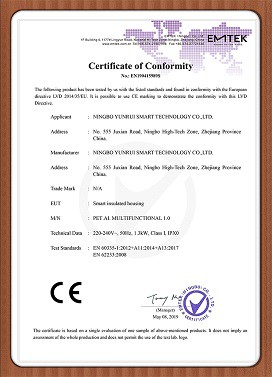Pet detection is an AI-powered pet camera feature that detects your pet's movement and alerts you when they come into the camera's view. The technology uses sophisticated algorithms to analyze video footage and identify motion patterns.
Enhanced Safety and Security
Pet detection can significantly improve home security. By installing cameras and using pet detection software, homeowners can monitor their pets' activities when they are not at home. This allows them to take appropriate action in case of any unusual or emergency situations, such as intrusions or pets getting into dangerous areas.
Automated Pet Care
Pet detection technology can be integrated with smart home systems to automate pet care tasks. For example, it can trigger the automatic feeding dispenser when it detects that the pet is hungry or thirsty. Similarly, it can adjust the temperature or lighting in the house based on the pet's preferences and needs. This provides convenience for pet owners and ensures that their pets are well-cared for even when they are not at home.
Behavior Analysis and Training
Pet detection systems can analyze the pets' behavior patterns and provide valuable insights to owners. By tracking the pets' movements and activities, owners can understand their pets' preferences, routines, and any potential behavioral issues. This information can be used for effective training and behavior modification, improving the pets' quality of life and strengthening the bond between pets and their owners.
Enhanced User Experience
Pet detection technology can enhance the user experience when interacting with pets. For example, in video conferencing applications, the system can automatically detect and focus on the pet, allowing pet owners to have a more intimate and engaging experience with their pets when they are apart.
Health Monitoring and Early Disease Detection
Pet detection systems can be used to monitor the health and well-being of pets. By analyzing the pets' appearance, posture, and movements, the system can detect any abnormalities or changes that may indicate health issues. This allows pet owners to take early action and seek medical attention promptly, improving the pets' prognosis and outcomes.
Personalized Pet Care Products and Services
Pet detection technology can be used to develop personalized pet care products and services. By understanding the pets' preferences, needs, and behaviors, companies can create customized products such as toys, food, and bedding that better suit the pets' individualities. Additionally, they can offer personalized services such as training, grooming, and daycare that cater to the specific needs of each pet.
Why Choose Us
Competitive Prices
We offer our products at competitive prices, making them affordable for our customers. We believe that high-quality products should not come at a premium, and we strive to make our products accessible to all.
Efficient And Convenient
The company has established marketing networks around the world to provide high-quality services to customers in an efficient and convenient manner.
Advanced equipment
We take great measures to ensure that we work with the industry’s highest quality equipment and that our equipment is regularly and meticulously maintained.
High quality products
We always put customer needs and expectations in the first place, refine on, continuous improvement, to seek every opportunity to do better, to provide customers with their expectations of quality products, to provide customers with the most satisfactory service at anytime.
Rich Experience
Has a long-standing reputation in the industry, which makes it stand out from its competitors. With over many years of experience, they have developed the skills necessary to meet their clients' needs.
Professional team
We have a team of skilled and experienced professionals who are well-versed in the latest technology and industry standards. Our team is dedicated to ensuring that our customers get the best service and support possible.
Types of Pet Detection
Video Surveillance with Motion Detection
Home security systems often include motion sensors that can distinguish between pets and humans. These systems use machine learning algorithms to analyze video feeds and detect specific movements or shapes indicative of a pet.
RFID and Microchip Scanners
Many pets are implanted with RFID microchips for identification purposes. Scanners can read these chips to retrieve owner information in case of a lost pet. This technology is also used in automatic feeding bowls that release food only when the pet's microchip is detected.
GPS Tracking Collars
Wearable GPS devices allow owners to track their pets' location via a smartphone app or online interface. These collars are particularly useful for pets prone to wandering off or for those who live in areas without clear line-of-sight for satellite communication.
Biometric Recognition
Some advanced systems use biometric recognition, such as facial or voice recognition, to identify individual pets. This technology can be integrated into pet doors that open only for authorized pets, enhancing security and preventing unauthorized access.
Activity and Health Monitors
Devices that attach to a pet's collar can monitor physical activity levels, sleep patterns, and even vital signs like heart rate and temperature. This information can help owners ensure their pets maintain a healthy lifestyle and detect any potential health issues early on.
Interactive Toys and Camera Systems
Pet cameras with built-in treat dispensers can detect when a pet is nearby and allow owners to interact with them remotely. These systems often have motion sensors and may include object recognition capabilities to identify specific pets.
Material of Pet Detection
Infrared sensors are commonly used in pet detection systems to detect the presence of pets. These sensors emit infrared radiation and measure the reflection or absorption of the radiation to determine the presence of a pet. Infrared sensors are typically made of semiconductor materials, such as silicon or gallium arsenide, which have high sensitivity to infrared radiation.Ultrasonic sensors are another type of sensor used in pet detection systems. These sensors emit high-frequency sound waves and measure the time it takes for the sound waves to bounce back after hitting an object, such as a pet. Ultrasonic sensors are often made of piezoelectric materials, such as quartz or ceramics, which can generate and detect ultrasonic waves.
RFID tags are small electronic devices that can be attached to pets to enable their identification and tracking. These tags consist of a microchip and an antenna, which are typically encased in a plastic or silicone material. The microchip contains unique identification information, and the antenna allows the tag to communicate with RFID readers in the pet detection system. Optical sensors, such as cameras or image sensors, are used in some pet detection systems to capture images or video footage of pets. These sensors are typically made of semiconductor materials, such as silicon, and are sensitive to visible light or infrared light. Optical sensors can be combined with image processing algorithms to detect and identify pets based on their visual characteristics.
Some pet detection systems utilize conductive materials to create physical barriers or boundaries that pets are not supposed to cross. These materials can include conductive wires, strips, or mats that emit a low-level electrical current. When a pet comes into contact with the conductive material, it completes an electrical circuit, triggering an alert or deterrent mechanism. While not a physical material, software and algorithms play a crucial role in pet detection systems. These systems often rely on complex algorithms to analyze sensor data, process images or video footage, and identify patterns or behaviors associated with pets. The software component of the pet detection system can be programmed to differentiate between pets and other objects or to recognize specific pet characteristics.
Pet Type and Behavior
Different pets have different behaviors and activity patterns. For example, dogs and cats may be more active at certain times of the day, while aquatic pets like fish or turtles require less monitoring.
Young pets, especially puppies or kittens, may require more frequent monitoring due to their curiosity and tendency to explore.
Environmental And Safety Considerations
The environment in which your pet lives is crucial. Indoor pets may require less monitoring than outdoor pets, which may be at risk of escaping or interacting with wildlife.
Safety issues, such as pets straying into hazardous areas or interacting with hazardous materials, may require more frequent inspections.


Purpose Of Pet Testing
The purpose of pet testing determines the frequency of monitoring. For example, pet tracking for behavioral analysis may require constant monitoring, while occasional health checks may be enough for some owners.
Pet detection for security purposes, such as monitoring for intruders or ensuring pets are not left unattended, may require continuous or near-continuous monitoring.
Resources and Accessibility
The availability of resources such as time, money, and technology affects the frequency of pet testing. Homeowners with limited time or resources may choose less frequent inspections.
Advanced technologies such as smart cameras or sensors can provide real-time monitoring and alerts, allowing owners to adjust the frequency of monitoring based on their pet’s activity and needs.
Legal and Ethical Considerations
Some countries or regions may have laws or ethical guidelines regarding pet monitoring. Owners should familiarize themselves with these regulations and abide by them when determining how often their pets should be tested.
Process of Pet Detection
Before the test, the veterinarian usually conducts a consultation to understand the pet's medical history, symptoms, and living environment. This helps the veterinarian to determine which tests are needed and to develop a personalized test plan. The veterinarian conducts a comprehensive physical examination of the pet, including checking the pet's body, eyes, ears, nose, mouth, skin, and hair. During the examination, the veterinarian may also check the pet's heart rate, respiratory rate, and body temperature. Laboratory tests are one of the most common methods of Pet Detection. These tests may include blood tests, urine tests, and stool tests. Blood tests can help detect infectious diseases, internal organ diseases, and metabolic disorders. Urine and stool tests can help detect kidney and digestive system diseases. Imaging tests, such as X-rays, ultrasounds, CT scans, and MRI scans, can help detect abnormalities in the pet's internal organs, bones, and soft tissues. These tests can help diagnose conditions such as tumors, fractures, and organ damage. Endoscopy, including gastroscopy, colonoscopy, and bronchoscopy, can help detect abnormalities in the pet's digestive tract, respiratory tract, and other internal organs. Biopsy is a test that involves taking a sample of tissue or cells from the pet's body for examination. This test can help detect cancer and other diseases.
The first component of pet detection is the input source, which is usually an image or video feed. This input can come from a camera or a pre-recorded video file. The second component is the object detection algorithm, which is responsible for identifying pets in the input image or video. This algorithm uses machine learning techniques to analyze the input and identify objects that match the characteristics of pets. Once the object detection algorithm has identified pets in the input, the next step is to extract features from the detected objects. These features can include things like the size, shape, and color of the pet. The extracted features are then fed into a classification model, which is responsible for determining the type of pet that has been detected. This model can be trained on a large dataset of pet images to accurately classify different types of pets.Finally, the output of the pet detection system is displayed to the user. This can be in the form of a visual display, such as a video feed with bounding boxes around detected pets, or an audio alert that notifies the user when a pet has been detected.
Maintenance Pet Detection
Regular health checks are an important part of Pet Detection. The veterinarian will check the pet's body, eyes, ears, nose, mouth, skin, and hair to detect any abnormalities or signs of disease. At the same time, the veterinarian will also conduct some basic tests, such as blood tests, urine tests, and stool tests, to detect any potential health problems.
Vaccinations and parasite prevention are also important parts of Pet Detection. The veterinarian will recommend the appropriate vaccinations and parasite prevention measures based on the pet's species, age, and health status to protect the pet from infectious diseases and parasites. Dental care is also an important part of Pet Detection. Regular brushing and dental cleaning can help prevent dental diseases such as tartar and periodontitis.
A reasonable diet and balanced nutrition are also important parts of Pet Detection. The veterinarian will recommend an appropriate diet and nutritional supplements based on the pet's species, age, and health status to ensure that the pet gets enough nutrients. The pet's living environment and behavior are also important parts of Pet Detection. The veterinarian will advise on appropriate housing, exercise, and behavior management to ensure that the pet lives a healthy and comfortable life.
Diagnostic Capabilities
Pet detection technologies, such as wearable devices or smart cameras, can monitor a pet's activity, sleep patterns, and environment. However, they cannot detect diseases or health conditions that require a more comprehensive diagnostic approach.
Physical exams and lab tests allow veterinarians to perform detailed assessments of a pet's physical condition, including checking for abnormalities, listening to heart and lung sounds, and conducting blood tests to detect infections or other health issues.
Comprehensive Analysis
Pet detection can provide insights into a pet's daily life, but it cannot capture the complexity of a pet's overall health status. Physical exams and lab tests provide a more comprehensive picture of a pet's health by considering multiple factors, including age, breed, genetics, and lifestyle.
Veterinarians can interpret the results of these tests to diagnose conditions, recommend treatment plans, and monitor the progress of recovery.
Expertise and Experience
Pet detection technologies may provide data, but interpreting and understanding these data require expertise and experience. Veterinarians have years of training and practice in diagnosing and treating pet health conditions.
They can utilize their knowledge and skills to interpret the data provided by pet detection technologies, but they also rely on physical exams and lab tests to confirm diagnoses and monitor treatment effectiveness.
Emergency Situations
Pet detection technologies may alert owners to changes in a pet's behavior or environment, but they cannot respond to emergencies or provide immediate medical care. In cases of acute illness or injury, prompt veterinary care is crucial.
Veterinarians can assess the pet's condition, provide emergency treatment, and refer them to specialists if necessary.
Cost and Accessibility
Pet detection technologies can be costly and may not be accessible to all pet owners. In contrast, physical exams and lab tests are widely available and often included in routine pet care plans.
How Is Pet Detection Different From Other Animal Tracking Technologies
Targeted Species
Pet detection specifically targets domesticated pets, whereas other animal tracking technologies may focus on tracking wildlife, livestock, or endangered species. The algorithms and models used in pet detection are trained specifically on the characteristics and behaviors of pets, making them more accurate in identifying and tracking these animals.
Environmental Constraints
Pet detection systems are designed to work in indoor and outdoor environments that are typically encountered by pets. This includes homes, parks, streets, and other common areas where pets may roam. Other animal tracking technologies may be designed for specific environments, such as forests, oceans, or agricultural areas, and may have different constraints and requirements.
Behavior Analysis
Pet detection systems often incorporate behavior analysis to provide additional insights into the pet's activities and well-being. For example, they may track the pet's movement patterns, sleep duration, or eating habits. This can be useful for monitoring the health and behavior of pets, as well as detecting any unusual or abnormal activities.
Integration With Pet-related Services
Pet detection technologies can be integrated with other pet-related services, such as pet monitoring systems, pet health trackers, or smart pet feeders. This allows pet owners to have a comprehensive view of their pet's activities and well-being, and enables them to take appropriate actions based on the data collected.
User Interface And Interaction
Pet detection systems often have user-friendly interfaces that are designed for pet owners or caregivers. These interfaces may include features like real-time notifications, remote monitoring, and easy access to historical data. Other animal tracking technologies may have different user interfaces tailored to the specific needs of researchers, conservationists, or farmers.
How Can I Learn More About Pet Detection Technology
You can use search engines to find relevant information about pet detection technology, such as articles, blogs, and forums. You can also visit some professional websites and organizations to learn about the latest developments and applications of pet detection technology. There are many professional books and papers on pet detection technology, which can provide in-depth knowledge and understanding of this technology. You can search for relevant books and papers in libraries or online academic databases. There are many conferences and exhibitions on pet detection technology, which can provide opportunities to learn about the latest technologies and applications, and communicate with industry experts and peers. You can search for relevant conferences and exhibitions online and attend them as needed. There are many professional organizations and communities in the field of pet detection technology, which can provide opportunities to communicate and learn with industry experts and peers. You can search for relevant organizations and communities online and join them as needed. If you have specific needs for pet detection technology, you can contact pet detection technology service providers to learn about their products and services, and ask for more information and advice.
Our Factory
Ningbo Light Medical Technology Co., Ltd. Is a collection of research and development, production and sales for the integration of high and new tech enterprise. Proceeding from clinical requirements in veterinary medical industry, it is committed to developing exclusive devices in the field of intelligent veterinary medical care. Wu Yufu, as the founder of the company, is the national registered veterinarian with nearly 20 years of animal clinical experience.

Certifications






FAQ
Q: How is pet detection powered?
Q: Can pet detection be used in rural areas?
Q: Is pet detection safe for pets?
Q: How is pet detection regulated by governments?
Q: How can I choose the right pet detection system for my needs?
Q: Can pet detection be used in conjunction with other security measures?
Q: How often should pet detection systems be maintained?
Q: Can pet detection systems be customized to meet specific needs?
Q: How long do pet detection systems last?
Q: What are some emerging trends in pet detection technology?
Q: How can I learn more about pet detection technology?
Q: How does pet detection work?
Q: What are the benefits of pet detection?
Q: How accurate is pet detection technology?
Q: Can pet detection be used to find lost pets?
Q: How is pet detection different from facial recognition technology?
Q: Can pet detection be used in shelters or boarding facilities?
Q: Is pet detection available for all types of pets?
Q: How much does pet detection cost?
Q: How is pet detection different from other animal tracking technologies?
As one of the leading pet detection manufacturers and suppliers in China, we warmly welcome you to wholesale or buy discount pet detection for sale here from our factory. All customized medical equipment are with high quality and competitive price.
stainless steel cat cages for shelters, pet ct for prostate cancer, pet scan to detect cancer



